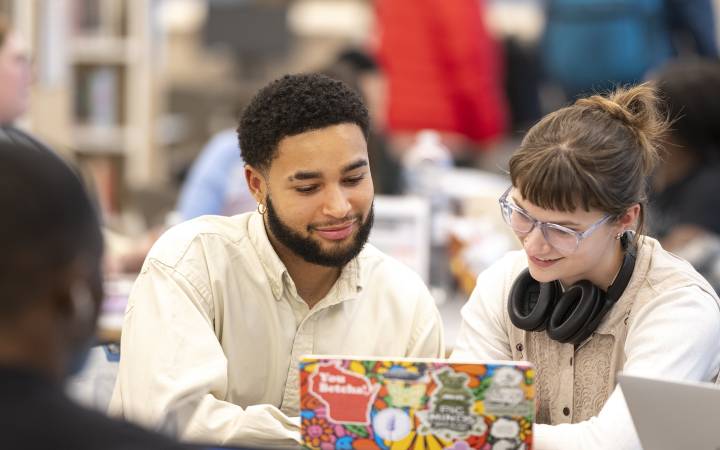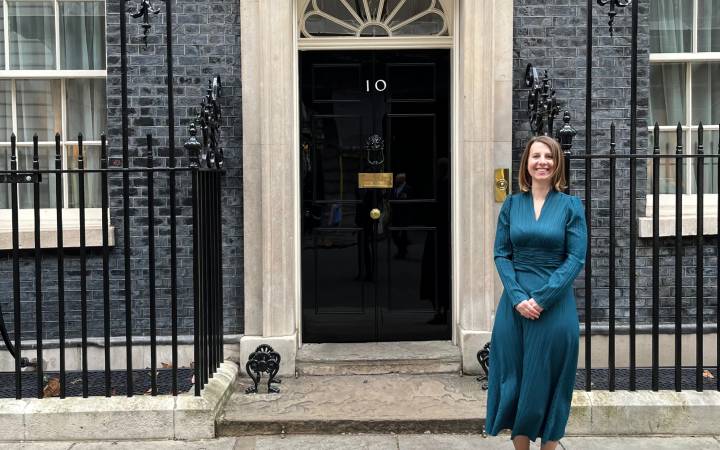Life, work and eco-socialism of William Morris inspires Wallpaper Man exhibition from Kingston School of Art students, academics and alumni
Posted Monday 30 November 2020
 William Morris wallpaper was used as the cover of a book produced by journalism students Nora Marie Vatland and Martine Aamodt Hess.
William Morris wallpaper was used as the cover of a book produced by journalism students Nora Marie Vatland and Martine Aamodt Hess.
A sustainable tracksuit made from hemp and natural dyes, an Artificial Intelligence algorithm creating patterns from archival data and a typeface developed from chisel marks are just a few of the many innovative projects inspired by the work of William Morris at a newly launched exhibition. Originally conceived before the lockdown, the exhibition hopes to encourage a new audience to discover the life and work of the British textile designer, poet, novelist, translator, and socialist activist.
Launched in collaboration with the William Morris Society, the exhibition showcases new works from designers, fine artists, journalists and creative writers each responding to one of three curated quotes from William Morris around protest and social commentary, innovation and technology, and usefulness and beauty. The students, alumni and academics from Kingston School of Art work under the banner of the StoryBox Collective, named after a collection of objects that together tell a story about a theme or aspect of a subject or artist.
Born in 1834, William Morris made his name as a designer whose decorative art and distinctive patterns are still influential to artists and designers today. He was one of the most significant figures in the arts and crafts movement, designing tapestries, wallpaper, fabrics, furniture, and stained glass windows. The Victorian is also known for his writing, while in the 1880s Morris became a committed revolutionary socialist activist.
 Fine Art graduate Ella Chedburn created an Artificial Intelligence producing new designs based on scans from the William Morris archive.The pandemic put paid to the research project's public display, however, the exhibition is physically represented by a recycled acrylic model of Kelmscott House, William Morris' home from 1878 until his death in 1896 - now a museum and base of the William Morris Society. The replica house has three floors, representing each of the three themes members of the collective based their artworks.
Fine Art graduate Ella Chedburn created an Artificial Intelligence producing new designs based on scans from the William Morris archive.The pandemic put paid to the research project's public display, however, the exhibition is physically represented by a recycled acrylic model of Kelmscott House, William Morris' home from 1878 until his death in 1896 - now a museum and base of the William Morris Society. The replica house has three floors, representing each of the three themes members of the collective based their artworks.
StoryBox founder and curator and the Design School's Teaching and Learning director Clare Conway explained that a chance overhearing of a snatch of conversation had inspired the exhibition's title ‘Wallpaper Man'. "I was standing outside Kelmscott House and heard some visitors describe William Morris as the wallpaper man," Ms Conway explained. "I wanted to tell them he's so much more than that – but that's what people feel. You can buy his fabric everywhere, things become devalued with over familiarity and sometimes a refocusing of the lens can remind people of the full value of a person's legacy."
For Ms Conway it was the discovery of Morris' Marxist writings, and his essays on man's destruction of nature, that provided an inspirational spark and led to a call for collaborators. "The starting point was a pull out quote from one of his lectures, Hopes and Fears for Art: the prospects of architecture in civilisation. From there it became a conversation and an exercise in curating people. It's a really lovely story of little pockets of collaboration with William Morris bringing everyone together."
Collaboration has been key in the process of many of the pieces produced for the exhibition. One such project saw sustainable design graduate Leo Russo, work in close collaboration with fashion graduate Amy Turnbull and graphic design graduate Joseph Montagu. They produced a sustainable fleece lined organic hemp tracksuit, printed with organically dyed William Morris patterns in a handmade screen-printing studio built during lockdown. The vibrant red leisure suit gets its colour, Madder Red, from Madder root extract, one of the natural dyes in William Morris essay the Art of Dyeing.
 Product andSustainable Design MA graduate Leo Russo worked in close collaboration with fashion graduate Amy Turnbull and graphic design graduate Joe Montague to produce a sustainable tracksuit based on Morris\' patterns.
Product andSustainable Design MA graduate Leo Russo worked in close collaboration with fashion graduate Amy Turnbull and graphic design graduate Joe Montague to produce a sustainable tracksuit based on Morris\' patterns.Technology was another theme addressed by the collective, with work based around the quote "I believe machines can do everything - except make works of art." Fine Art graduate Ella Chedburn was inspired to challenge the quote, creating an Artificial Intelligence producing new designs based on more than 500 scans from the William Morris archive.
Although the pandemic delayed the exhibition, for many the lockdown allowed further time to explore Morris' teachings in a way that wouldn't have been possible in normal life. Inspired by William Morris' ideas of craftsmanship, final year Graphic Design student Chloe Hulse developed a new typeface, using a chisel to cut into wood, finding shapes produced by the interplay between tool and material.
Journalism students Nora Marie Vatland and Martine Aamodt Hess, childhood friends from Norway, produced a sumptuous 16 page book, infusing their writing on sustainability with quotes from William Morris, highlighting his eco-socialist stance. The process saw the second year students learn how to letterpress, using a typeface created for the project by Graphic Design student Jack Niblett, while they also learned book binding from the dedicated technical staff in the KSA workshops.
Curator at the William Morris Society, Mallory Horrill, said she had been blown away by the calibre of talent and skill the students, recent graduates, and alumni had brought to this project. "William Morris is an individual of relevance as he was both a leading designer of the British Arts and Crafts movement and a pioneer in socialist and environmentalist thinking," she said. "I've found it particularly interesting seeing the different aspects of Morris that have spoken to each person and maker. The range of pieces very much reflects Morris' polymathic character - from printing to textiles, politics to ceramics. It has been a privilege for the Society to be involved in this project and to be a part of introducing Morris to this new generation of creatives."
- See more of the exhibition on the StoryBox Collective website.
- Find out more about studying at Kingston School of Art.
Contact us
General enquiries:
Journalists only:
- Communications team
Tel: +44 (0)20 8417 3034
Email us



